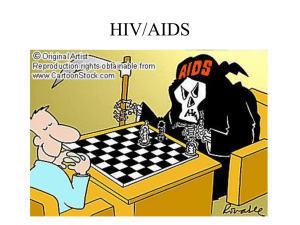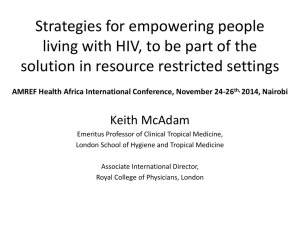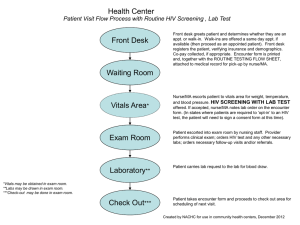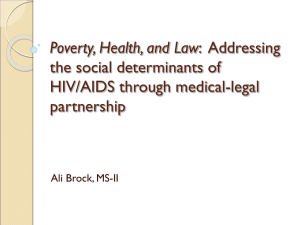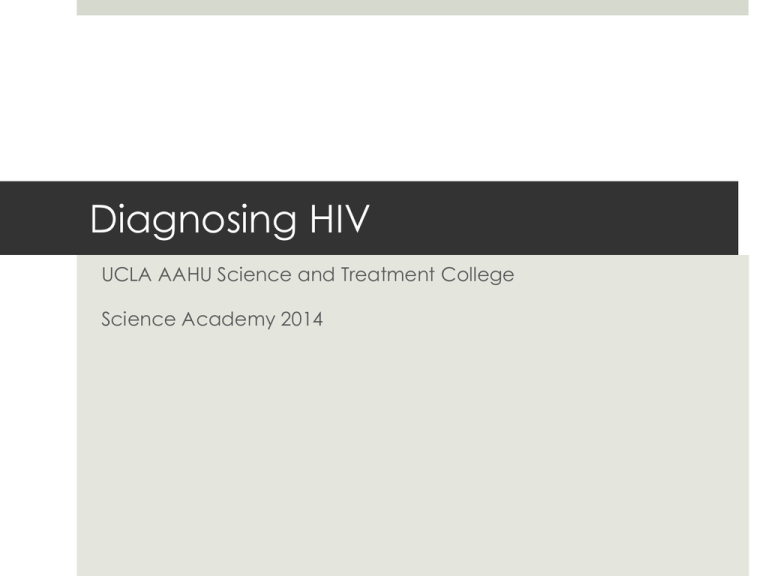
Diagnosing HIV
UCLA AAHU Science and Treatment College
Science Academy 2014
Outline of Talk
Principles of Diagnosing HIV
How HIV is Diagnosed
Consequence of Diagnosing HIV
Discussion questions
History of HIV Testing
HIV as the cause of AIDS discovered several years after
the disease was first characterized
Tests to detect HIV infection developed in 1985
Initial large scale testing was focused on testing blood
supply
Testing in individuals became more widespread due to
multiple factors:
Knowledge that HIV spread with sexual contact and from
mother to child
Development of successful treatments
Question:
Why is diagnosing HIV important?
To start early effective therapy and prevent spread of disease
Reasons Diagnosing HIV infection
Important
Early diagnosis can allow for early treatment
More evidence shows this can improve disease outcome
Effective treatment also decreases likelihood of spread
Partners of HIV infected individual can also be tested
HIV is Under-Diagnosed
It is estimated that 16% of people living with HIV
in the United States are unaware of their
diagnosis
In one study in New York, 32,534 consecutive patients were
screened for HIV; 0.45% tested positive, and of these, 29% were new
diagnoses
In Sub-Saharan Africa as many as 50% of
people living with HIV are undiagnosed
Question:
Who Should Be Tested for HIV?
Screening vs. targeted testing, and issues of confidentiality
Universal HIV Screening
Major guidelines are similar
2006 CDC: all patients age 13-64
2009 American College of Physicians: all patients age 13-75
2013 U.S. Preventative Services Task Force: all patients age
15-65
The bottom line: everybody in the US should be screened
This is most practically done at the first “establish care”
visit or at the time of a first hospitalization
Exception: if the established prevalence of HIV is < 0.1%
(e.g. in North Dakota)
Frequency of Screening
For persons who are “low-risk,” one time is reasonable
For high-risk patients, can be up to every three months
IV drug use
Men who have sex with men
Partners of HIV infected individuals or individuals with
unknown HIV status
Sex workers
People taking pre-exposure prophylaxis
Targeted Testing
Recent HIV exposure
Symptoms suggestive of new HIV infection
Occupational exposure (e.g. needle stick)
Blood or organ donors
Pregnancy (every time)
Consent and Confidentiality
Do you need consent before you test somebody?
Historically, written consent was required prior to testing a
patient for HIV
In 2006 CDC instead recommended “opt-out” testing, i.e.
the patient is informed verbally that an HIV test will be sent,
and she has the ability to decline, or “opt-out”
Since 2006 every state except Nebraska has eliminated
written consent for HIV testing
With increased testing, confidentiality is essential
Patients should always be reassured and reminded that their
results will only be discussed with them
Discussion Question 1:
Which of the following patients do NOT need to
be tested for HIV?
A) Healthy 34yo woman presenting to establish care under
her new HMO
B) 72yo man who presents to the emergency room with
chest pain
C) 20yo man with Down syndrome, developmental delay,
admitted for pneumonia
D) 50yo man presenting with fevers, rash, and swollen lymph
nodes after a business trip to Thailand
Question:
How is the diagnosis of HIV
made? (Part I)
Clinically: signs, symptoms, and clinical history should prompt
suspicion of infection. Infection confirmed with laboratory testing.
Clinical History and Presentation of
HIV Infection: Early Disease
History of exposure: includes sexual exposure, injection
drug use, healthcare setting exposure, mother to child
transmission
Symptoms of acute infection are non-specific:
Constitutional (non-specific): fever, fatigue
Also lymphadenopathy, sore throat, rash, muscle and joint
pain, nausea/diarrhea, hepatitis, meningitis
10-60% may not experience any symptoms
Clinical History and Presentation of
HIV Infection: Advanced Disease
Period of clinical latency follows acute infection
Period with relatively few symptoms or signs
Immune system continues to be affected leading to
progressive immunosuppression and fall in CD4 T cells of the
immune system
Severe immunosuppression eventually occurs
Leads to development of opportunistic infections and
malignancies
Characterized by rare conditions not seen in people with
intact immune systems
Classification of HIV Disease: WHO
Stages
Herpes Zoster (Shingles):
varicella zoster virus
Seborrheic Dermatitis:
Malassezia fungus
Classification of HIV Disease: WHO
Stages (cont.)
Oral Candidiasis /
Thrush (WHO stage III)
HIV wasting syndrome
(WHO stage IV)
Classification of HIV Disease: CDC
Stages
Stage 0: Early
infection (within 6
months of
infection)
Stages 1, 2, and
3: Based on CD4+
T cell count and if
an opportunistic
infection has
occurred
Classification of HIV Disease: CDC
Stages: AIDS Defining Conditions
Bacterial infections, multiple or recurrent*
Candidiasis of bronchi, trachea, or lungs
Candidiasis of esophagus†
Cervical cancer, invasive§
Coccidioidomycosis, disseminated or
extrapulmonary
Cryptococcosis, extrapulmonary
Cryptosporidiosis, chronic intestinal (>1 month's
duration)
Cytomegalovirus disease (other than liver,
spleen, or nodes), onset at age >1 month
Cytomegalovirus retinitis (with loss of vision)†
Encephalopathy, HIV related
Herpes simplex: chronic ulcers (>1 month's
duration) or bronchitis, pneumonitis, or
esophagitis (onset at age >1 month)
Histoplasmosis, disseminated or extrapulmonary
Isosporiasis, chronic intestinal (>1 month's
duration)
Kaposi sarcoma†
Lymphoid interstitial pneumonia or pulmonary
lymphoid hyperplasia complex*†
Lymphoma, Burkitt (or equivalent term)
Lymphoma, immunoblastic (or equivalent term)
Lymphoma, primary, of brain
Mycobacterium avium complex or
Mycobacterium kansasii, disseminated or
extrapulmonary†
Mycobacterium tuberculosis of any site,
pulmonary,†§ disseminated,† or extrapulmonary†
Mycobacterium, other species or unidentified
species, disseminated† or extrapulmonary†
Pneumocystis jirovecii pneumonia†
Pneumonia, recurrent†§
Progressive multifocal leukoencephalopathy
Salmonella septicemia, recurrent
Toxoplasmosis of brain, onset at age >1 month†
Wasting syndrome attributed to HIV
Karposi Sarcoma: HHV-8
Non-Hodgkin
Lymphomas:
Discussion Question 2:
A 70 year old man who is a resident of a nursing
home has been having persistent weight loss and
diarrhea. He has been evaluated by several
physicians for possible GI diseases, but all that is
revealed is some oral thrush (candidiasis) and
persistent small amounts of blood in his stool. More
recently, the patient has been having increasing
confusion and disorientation. Do you suspect HIV
infection? If so, could all his symptoms be
explained by HIV infection?
Discussion Question 2:
HIV infection should be suspected when someone
presents with typical symptoms, regardless of age or their
living situation
Because he is having symptoms of HIV infection, you
would suspect advanced HIV infection
His weight loss and oral thrush are commonly associated
with HIV infection. GI bleeding can be a result of Karposi
Sarcoma or infection with opportunistic pathogen (CMV).
His disorientation can also be due to HIV infection
(encephalopathy) or infection with opportunistic
infection (Cryptococcus).
Question:
How is the diagnosis of HIV
made? (Part II)
A brief overview of HIV laboratory tests
Detect virus
components
Detect
antibodies
Image modified from rom niaid.nih.gov
From McMichael et al, Nat Rev Immunol, 2010; 10: 11-23
Available HIV Tests
Detection of virus components (early infection)
p24 Antigen test
HIV viral RNA test
Detection of host antibody response (2-3 weeks after
infection)
ELISA
Immunofluorescence assay
Western Blot
Rapid HIV test
Discussion Question 3:
A 24 year old man comes to clinic saying that he
started a new sexual relationship with an HIV
positive partner, and in the last 3 weeks he has
been having some fevers and swollen lymph
nodes with rash and diarrhea. One week ago he
had a rapid HIV test done that was negative. Are
you suspicious of HIV infection and how will you
confirm your suspicions?
Discussion Question 3:
Because of the history of exposure as well as the
presence of symptoms typical of acute or early infection,
suspicion is high
Having a negative rapid test is very likely because these
tests usually test for antibodies. Antibodies may not be
detectable in early infection
You will do further laboratory confirmation tests checking
for viral components (RNA and p24 capsid protein)
Question:
What are the consequences of a
new diagnosis of HIV?
A brief word on the psycho-social elements of HIV diagnosis
Psychosocial Consequences
HIV diagnosis is life-altering, shocking, and
psychologically disturbing
Depression is common
It profoundly affects all of the patient’s relationships
Important to provide psychological and mental health
services
Important to communicate that HIV is a chronic disease
and with proper treatment, life expectancy is normal
Summary
Diagnosing HIV is crucially important for individual health
and public health
Universal screening is recommended, with additional
targeted testing as indicated
Diagnosis is made by clinical history and two basic types
of laboratory tests
The more people we diagnose with HIV the more we
have to be prepared to help people learn to live with the
disease
Thank You!
References
Bartlett, Hirsch, and Mitty, UpToDate, “Screening and diagnostic testing for HIV
infction” 2014
CDC. Detection of Acute HIV Infection in Two Evaluations of a New HIV
Diagnostic Testing Algorithm – United States, 2011-2013, MMWR 2013; 62(24):489494.
Centers for Disease Control and Prevention and Association of Public Health
Laboratories. Laboratory Testing for the Diagnosis of HIV Infection: Updated
Recommendations. Available at http://stacks.cdc.gov/view/cdc/23447.
Published June 27, 2014.
CDC. Revised Recommendations for HIV Testing of Adults, Adolescents, and
Pregnant Women in Health-Care Settings. 2006; 55(RR14):1-17.
CDC. Revised Surveillance Case Definitions for HIV Infection- United States, 2014.
MMWR Recommendations and Reports 2014. Vol. 63 No. 3
References
Mandell, G. (2010). Principles and Practice of Infection Diseases. Mandel, G.,
Bennett, John., Dolin, R. (Ed.). Philadelphia, PA. Churchill Livingstone Elsevier.
Nasrullah et al., Performance of a fourth-generation HIV_ screening assay and an
alternative HIV diagnostic testing algorithm. AIDS 2013; 27:731-737.
Lin et al., Routine HIV screening in two health-care settings--New York City and
New Orleans, 2011-2013. MMWR Morb Mortal Wkly Rep. 2014;63(25):537.
Schweitzer, Mizwa, and Ross, Psychosocial aspects of HIV/AIDS: Adults
World Health Organization Case Definitions of HIV for Surveillance and Revised
Clinical Staging and Immunological Classification of HIV-Related Disease in Adults
and Children. World Health Organization, 2007. Geneva.
World Health Organization. Guidelines for the Implementation of Reliable and
Efficient Diagnostic HIV Testing, Region of the Americas. Pan American Health
Organization, 2008, Washington D.C.


